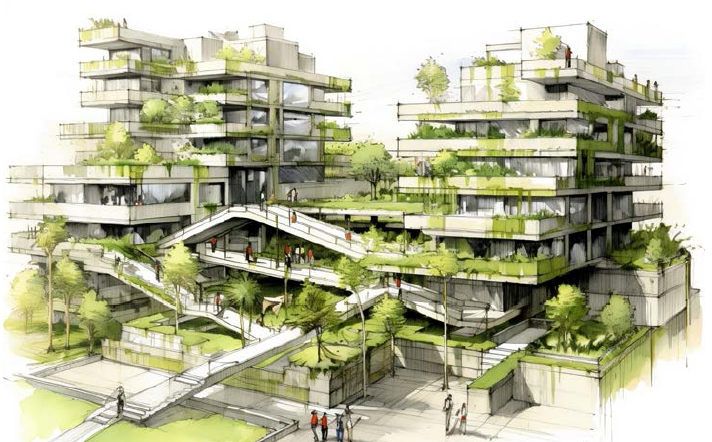
Options Magazine, Winter 2023: As cities draw in more and more people, the challenges and opportunities posed by urbanization are ever-increasing. How can we make sure that the cities of tomorrow will serve both people and the planet?
We live in an age where more than half of humanity calls cities their home, a figure expected to rise to over 70% by 2050. While cities offer promise and progress, increasing urbanization also has its perils —overcrowding, waste, air pollution, disease, and soaring temperatures.
Yet, things do not have to be this way, argued Michael Thompson, a researcher in the IIASA Population and Just Societies Program in a speech given at the Prada Frames Symposium on Waste in Milan this year. By re-engineering city infrastructure, we can lessen the massive ecological footprint of urban environments, “all the way to the point where our cities are walking on air,” as he puts it. But how can we transform urban environments in a way that ensures the wellbeing of both people and the planet? Thompson highlights three main courses of action: turning away from fossil fuels towards renewables, dealing with waste in a creative and value-changing way, and practicing city-forestry and city-farming, thereby making our cities greener.
“Electricity from renewables is now much cheaper than from fossil fuels and it is waste-free. Once we have taken human waste out of the water cycle, and reconceived it as a valuable resource, we will be quids-in and able to swim in our rivers without having to ‘go through the motions’,” writes Thompson. “With our cities becoming ever more forested, carbon dioxide is removed from the atmosphere, and the cities themselves are made more biodiverse and more livable.”
Fostering urban resilience and building sustainable cities are the focus of numerous research projects at IIASA, working towards mitigating the immense footprint of the urban giants and smaller towns alike while safeguarding the health and wellbeing of their inhabitants.
A LIVING, BREATHING ORGANISM
Much like human beings, cities have a metabolism, consuming energy, water, and resources, and producing waste. The study of urban metabolism models these flows to get a better understanding of how the resources are used and ways to reduce the possible negative environmental impacts.
The Resource Nexus for Transformation to Circular, Resilient, and Livable Cities in the Context of Climate Change (RECREATE) project focused on assessing the energy and carbon flows in four pilot cities: Beijing, Malmo, Shanghai, and Vienna. With this network-based approach, the researchers were able to identify the sectors directly and indirectly responsible for the most carbon dioxide emissions (manufacturing, transportation, and electricity production), pinpointing where policy changes would have the largest effect.
The process of building livable cities needs to include the people who live there, which is why the project also involved stakeholders and policymakers through interviews and co-creation workshops in the cities of Vienna and Shanghai.
“By identifying the values of people about what makes their city livable, we can create ‘untouchables’ in the models,” says Brian Fath, a researcher in the IIASA Advancing Systems Analysis Program. “Why bother going in directions in modeling scenarios that are undesirable to the people?”
LITERAL HOTSPOTS
Cities are particularly vulnerable to climate change because of the Urban Heat Island effect. Buildings and other urban structures without vegetation trap heat, leading to higher temperatures in the city compared to the surrounding countryside. Heatwaves cause thousands of deaths every year, as the human body is not able to cope with prolonged extreme heat.
Funded by the Austrian Climate Research Fund, the Urban Climate Change Adaptation for Austrian Cities: Urban Heat Islands (ADAPT-UHI) project was developed to support urban planners in creating strategies and action plans for climate change adaptation and mitigation in Austria. The project focused on Klagenfurt, Mödling, and Salzburg, three small to medium-sized cities that often get overlooked in heat island studies, which have tended to focus on major cities. The researchers came up with a series of recommendations, a number of which have since been included in their city strategies, such as planting more trees, using green or white roofs, and greening surfaces, among others.
“One of the most interesting results was to see that while Mödling would benefit if it implemented our recommendations, the benefits would be even higher if the surrounding regions implemented them too,” says
Linda See, a researcher in the IIASA Advancing Systems Analysis Program who led the project at IIASA. “We invited representatives from each of the regions to show them this result, and it was great to see people realizing that if they cooperated, their benefits would be even larger.”
A MASSIVE PILE OF GARBAGE
With so many people living in close proximity, working out what to do with the enormous amounts of waste generated in cities becomes a real challenge. Unmanaged waste is not just an aesthetic issue—without proper disposal, it can become a hazard for both humans and the environment.
While recent decades saw an increase in efforts towards recycling, globally only around 13% of waste is recycled and only 5.5% is composted. It is clear that we need to do better. IIASA researchers and colleagues from the University of Natural Resources and Applied Life Sciences in Vienna looked at future trends of global municipal waste generation and their impact on greenhouse gas emissions and air pollution if waste management systems stayed as they are now until 2050. Then, they assessed how implementing circular waste management systems where waste generation is minimized, materials are reused and recycled, and waste is collected and disposed of effectively could reduce waste and associated emissions.
“WASTE REDUCTION TOGETHER WITH THE ADOPTION OF CIRCULAR WASTE MANAGEMENT SYSTEMS WILL DELIVER A BROAD RANGE OF COBENEFITS INCLUDING REDUCTION OF GREENHOUSE GAS EMISSIONS, AIR, AND WATER POLLUTION"
“Waste reduction together with the adoption of circular waste management systems will deliver a broad range of co-benefits including reduction of greenhouse gas emissions, air, and water pollution,” says Adriana Gómez-Sanabria, a researcher in the IIASA Energy, Climate, and Environment Program. “All of this would contribute towards the realization of the Sustainable Development Goals.”
Following up on this research, Gómez-Sanabria and her colleagues are taking a closer look at preventing waste from leaking into waterways where the negative impacts on health and the environment are especially high. In an upcoming study, they identify the residential zones close to rivers, lakes, and coastal areas where the adoption of circular waste management systems should be prioritized.
CLOSING THE LOOP
Circularity isn’t only important in waste management, but it is also a crucial step in delivering on almost every aspect of agreements like the Sustainable Development Goals and the Paris Agreement. IIASA has been coordinating CircEUlar, a Horizon Europe project aiming to develop circular pathways for a low-carbon transition in the European Union, involving several research institutions across Europe.
The project combines stakeholder engagement, empirical analysis, and integrated modeling approaches with the goal of developing new methodological approaches for the modeling of circularity in the context of climate mitigation pathways, while considering the role of digitalization, mobility, buildings, and household services in detail.
“The demand-side focus of the research with emphasis on exploring the implications of new business models and changing consumer practices makes this a really exciting project to work on,” says Volker Krey, a researcher in the IIASA Energy, Climate, and Environment Program and the principal investigator on the project.
BY CITIZENS, FOR CITIZENS
Urbanization in Europe has an even more striking tendency than global estimates: by 2050 almost 85% of Europeans will live in cities. In an effort to make the transition more inclusive, an IIASA-led Horizon Europe project called Urban ReLeaf, aims to leverage the power of citizen science to co-create livable cities for the future, increasing the participatory aspect of city planning.
“We are collaborating with local communities and more specifically vulnerable groups to design inclusive urban greening strategies,” says Inian Moorthy, a researcher in the IIASA Advancing Systems Analysis Program and a co‑coordinator of the project.
The project focuses on climate change adaptation, green infrastructure, and urban design planning in six cities across Europe. As many cities lack the necessary data for robust green planning decisions, citizen science can help close these gaps. Some of the initiatives include creating a tree registry in some of the cities, distributing temperature, humidity, and air pollution sensors to citizens, as well as directly collecting citizens’ perceptions.
WHAT IS UNIQUE ABOUT THIS PROJECT IS THAT WE ARE DIRECTLY PARTNERING WITH CITY ADMINISTRATIONS
“What is unique about this project is that we are directly partnering with city administrations,” says Gerid Hager, a researcher in the IIASA Advancing Systems Analysis Program who co-coordinates the project with Moorthy. “Hopefully this will increase their commitment to work on these topics and to try to accelerate the uptake of citizen observations in their governance processes.” While there is a lot of data available to help policymakers discern the best strategy for governing urban environments, as Thompson writes, “everything hinges on governance: on getting all that re-engineering of city infrastructure to actually happen.”
Collaborating with city officials and citizens themselves is a crucial step to make the move from science towards real action; towards creating the green, sustainable, and inclusive cities of tomorrow.
By Fanni Daniella Szakal
Publications
Gomez Sanabria, A. , Kiesewetter, G. , Klimont, Z. , Schöpp, W. , & Haberl, H. (2022). Potentials for future reductions of global GHG and air pollutant emissions from circular municipal waste management systems. Nature Communications 13 art.no.106. 10.1038/s41467-021-27624-7.
Thompson, M. & Beck, M.B. (2015). Coping with change: urban resilience, sustainability, adaptability and path dependence. Future of cities: working paper. Foresight, Government Office for Science , London, UK.








